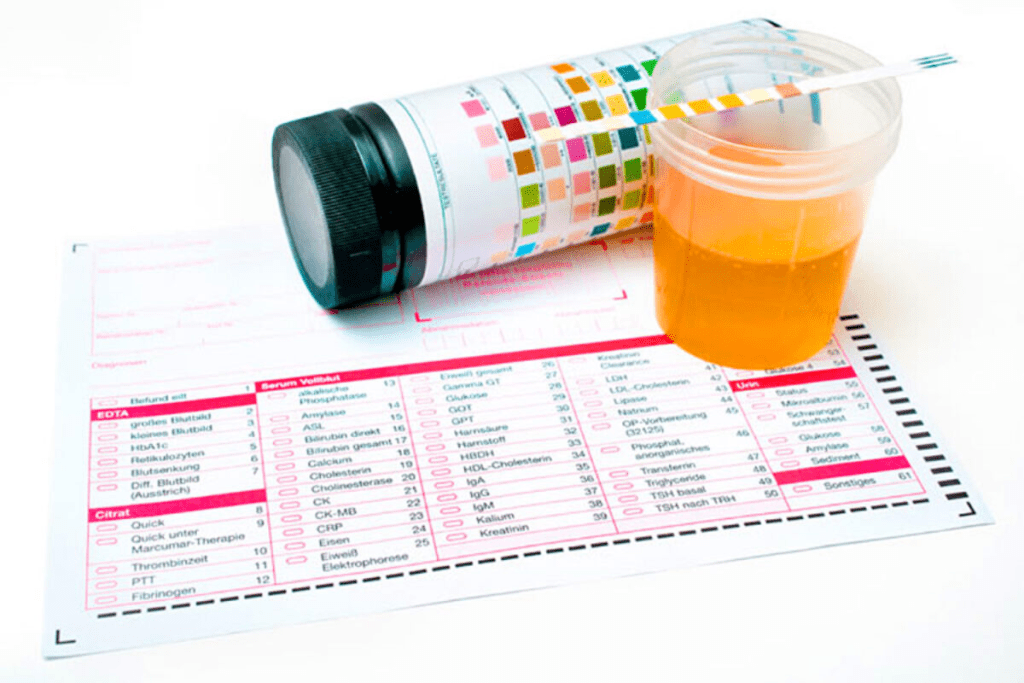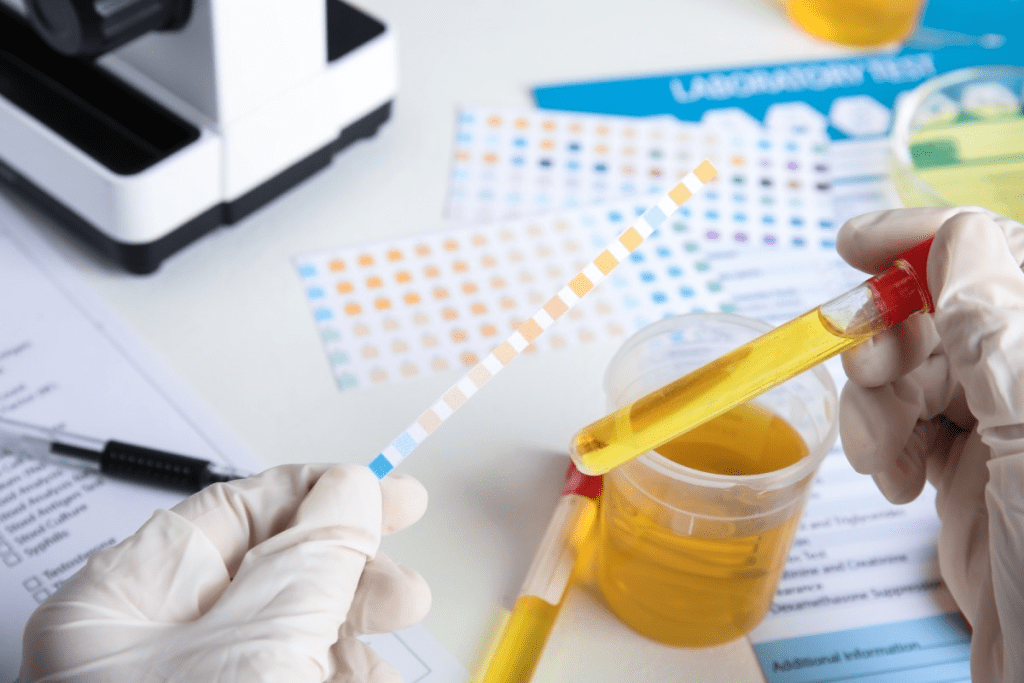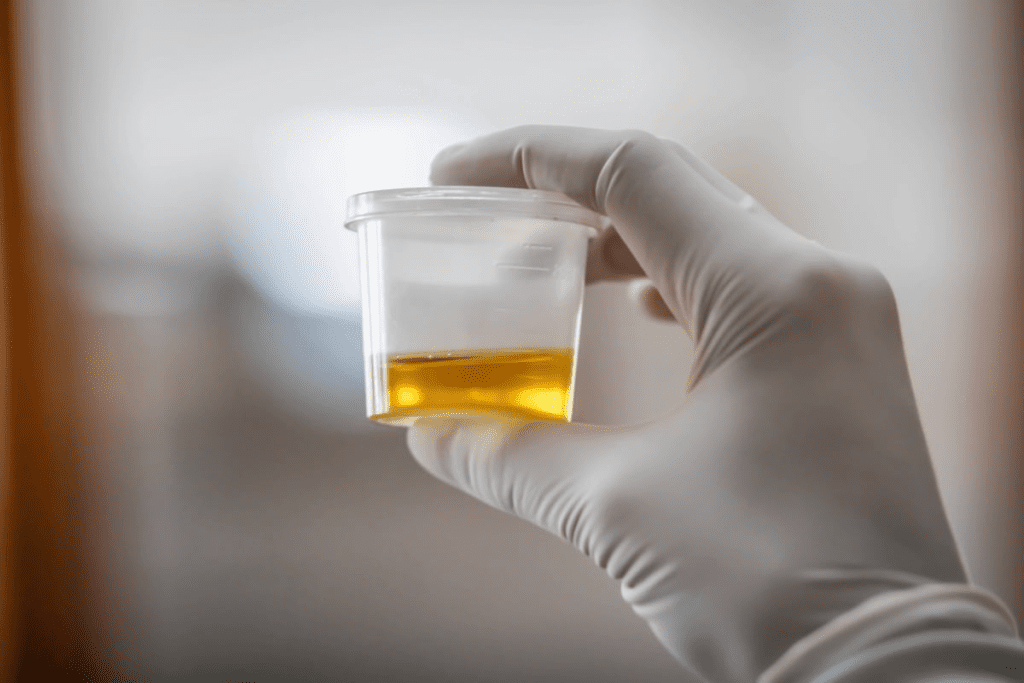Last Updated on November 25, 2025 by
What urinalysis indicates kidney failure? Learn which urinalysis results (proteinuria, low specific gravity) are the crucial, powerful signs of poor kidney function.
Early detection of kidney failure can greatly improve treatment outcomes. Yet, many people miss the early signs in routine urinalysis. We look at proteins, blood cells, and other urine abnormalities to spot kidney problems.

The presence of high protein levels in urine, known as proteinuria, is a major sign of kidney damage. The National Kidney Foundation says a simple urinalysis test can reveal conditions that may need treatment, including kidney failure.
The kidneys are vital for our health. Urinalysis helps check how well they work.
Kidneys are bean-shaped organs that do many important jobs. They filter waste and excess fluids from our blood. They also help control electrolyte levels and make hormones for strong bones and healthy red blood cells.
Every day, kidneys filter about 200 liters of blood. They remove waste and excess substances that could harm us. They keep our fluid balance right and ensure we have the right levels of electrolytes like sodium, potassium, and calcium.
A urinalysis is a simple test that looks at a urine sample. It helps find and track kidney and urinary tract problems. The test checks the urine’s color, clarity, and for certain chemicals and cells.
Urinalysis has three parts: a visual check, a dipstick test, and a microscopic look. The dipstick test quickly checks for things like protein, glucose, and ketones in the urine.

Checking urinalysis results is key to spotting kidney damage early. This test gives us important clues about how well our kidneys are working. It helps us find any problems.
Proteinuria (too much protein in the urine) is a big warning sign of kidney trouble. Normally, kidneys keep proteins and filter out waste. But if they’re damaged, they can’t do this right, and protein leaks into the urine.
Ketones in the urine also mean something’s off. It shows the body is using fat for energy instead of glucose. This can be a sign of diabetes, a common cause of kidney disease.
The urine albumin-creatinine ratio (uACR) is the top test for kidney damage. It checks how much albumin (a protein) is in the urine compared to creatinine, a waste product. A higher ratio means more kidney damage.
We prefer uACR because it’s more accurate than proteinuria alone. It takes into account how concentrated the urine is.

Specific gravity shows how concentrated the urine is. If it’s not normal, it could mean the kidneys are having trouble concentrating or diluting urine.
A fixed specific gravity means the kidneys can’t change the urine’s concentration. This is a sign of serious kidney damage.
Understanding blood and white cells in urinalysis is key to spotting kidney problems. Blood, or hematuria, and white blood cells, or leukocytes, show different health issues. These can range from infections to kidney damage.
Hematuria means red blood cells in the urine. A positive finding for RBCs in urinalysis can mean kidney stones, infections, or disease. We must look at how severe it is and what might have caused it to give the right care.
Leukocytes, or white blood cells, in urine show the body’s fight against infection or inflammation. They can mean urinary tract infections (UTIs) or kidney infections. Knowing about leukocytes in urinalysis helps us diagnose and treat these issues well.
Seeing both blood and leukocytes in urine means a more serious issue. It could be a severe infection or serious kidney damage. We need to carefully look at these signs to find the cause and plan the right treatment.
Some casts and sediments in urine can show kidney problems. Urinalysis is a key tool for checking kidney health. It looks at what’s in the urine.
Urine casts are formed in the kidneys. They can be made of cells, proteins, and more. Hyaline casts are common and often seen after exercise or when we’re dehydrated. But, other casts can mean kidney damage or disease.
There are different casts in urine, like:
Casts tell us a lot about kidney tubule function. The presence of certain casts can show damage to the renal tubules. These tubules are key for filtering waste and excess fluids.
For example, cellular casts with white blood cells mean there’s inflammation in the kidneys.
Other sediments in urine also give important clues. WBC UA (white blood cell count in urinalysis) is very important. High levels can mean urinary tract infections or kidney inflammation. Bacteria, yeast, or crystals in urine are also significant.
These findings help doctors diagnose and treat. For instance, white blood cells in urine, along with other sediments, can help spot conditions like pyelonephritis or kidney stones.
Chronic kidney disease (CKD) often goes unnoticed, with about 90% of cases undiagnosed. This highlights the urgent need for regular tests to catch kidney disease early. Early detection makes it easier to manage the condition.
CKD often progresses quietly, with symptoms appearing only after significant damage. The lack of early signs, combined with low awareness and screening, leads to many undiagnosed cases. Early detection is vital to prevent further damage, as stated by health experts.
“Chronic kidney disease is a major public health problem worldwide,” health experts say. “Early detection through routine testing can significantly improve outcomes for patients with CKD.”
A normal urine leukocyte count is between 0 to 5 white blood cells per high power field (WBC/HPF). An elevated count can signal kidney damage or disease. It’s important to know the difference between normal and abnormal results to diagnose and manage CKD.
Those at risk of CKD should have regular urinalysis. The testing frequency depends on individual risk factors, like diabetes or family history of kidney disease. We suggest annual testing for those at risk.
Early detection of kidney disease through routine testing allows for proactive management. As healthcare providers, we stress the importance of regular urinalysis in identifying CKD and improving patient outcomes.
Abnormal urinalysis results can show kidney damage or disease. This means we need to take action to stop it from getting worse.
Urinalysis is key in finding kidney problems. It can show protein, ketones, and specific gravity issues. These signs mean our kidneys might be stressed or failing.
When we get abnormal results, we need to find out why. Then, we work with doctors to make a plan to fix it.
Acting fast on these results can really help with kidney disease. It can make a big difference in how well we feel and live.
Being proactive about our urinalysis results helps protect our kidneys. It’s a step towards preventing more damage.
A urinalysis is a test that checks urine for proteins, blood cells, and other signs. It helps find kidney problems early. This is key for keeping an eye on kidney health.
Proteinuria, or albuminuria, shows kidney damage. It means the kidneys are not working right. This is a big warning sign.
The uACR is top for spotting kidney damage. It looks at albumin to creatinine in urine. This gives a clear picture of kidney health.
Hematuria means there’s blood in urine. It can point to kidney damage, infections, or other problems. Finding out why is important.
Leukocytes, or white blood cells, in urine show an infection or inflammation. They mean there’s a problem that needs fixing.
Casts and sediments in urine hint at kidney damage or disease. Different casts tell us about kidney tubule function. They help understand kidney health.
A normal urine leukocyte count is zero or very low. But, abnormal counts mean there’s an infection or inflammation. This might need more tests or treatment.
People at risk of kidney disease or with kidney issues should get regular tests. How often depends on their situation. A doctor will advise.
Ketones and protein in urine point to kidney damage or disease. Ketones show blood sugar issues. Proteinuria is a clear sign of kidney damage.
Abnormal specific gravity in urinalysis shows kidney function problems. It might mean the kidneys can’t concentrate or dilute urine. This could be a sign of damage or disease.
Subscribe to our e-newsletter to stay informed about the latest innovations in the world of health and exclusive offers!